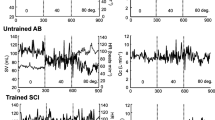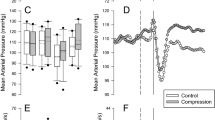Abstract
Despite loss of centrally mediated sympathetic vasoconstriction to the legs, spinal cord-injured individuals cope surprisingly well with an orthostatic challenge. This study assessed changes in leg vascular resistance following head-up tilt in healthy (C) and in paraplegic (P) individuals. After 10 min of supine rest, subjects were tilted 30° head-up. Mean arterial pressure (MAP) and total peripheral resistance (TPR) increased in C (MAP from 76.7±6.6 mmHg to 80.6±8.2 mmHg; TPR from 1.12±0.26 AU to 1.19±0.31 AU) while both remained unchanged in P. Echo Doppler ultrasound determined red blood cell velocity in the femoral artery, which decreased (P from 18.9±6.2 cm/s to 12.5±4.5 cm/s, P=0.001; C from 16.3±6.2 cm/s to 10.8±5.0 cm/s, P=0.001) and leg vascular resistance, which increased (P from 402±137 AU to 643±274 AU, P=0.001; C from 238±68 AU to 400±122 AU, P=0.003) from supine to upright. The present study shows that independent of supraspinal sympathetic control, humans are able to increase leg vascular resistance and maintain blood pressure during head-up tilt.



Similar content being viewed by others
References
Andersen EB, Boesen F, Henriksen O, Sonne M (1986) Blood flow in skeletal muscle of tetraplegic man during postural changes. Clin Sci 70:321–325
Andersen EB, Boesen F, Henriksen O (1991) Local and central sympathetic reflex control of blood flow in skeletal muscle and subcutaneous tissue in normal man. Clin Physiol 11:451–458
Bayliss WM (1902) On the local reactions of the arterial wall to changes in internal pressure. J Physiol (London) 28:220–231
Bellard E, Fortrat JO, Dupuis JM, Victor J, Leftheriotis G (2003) Haemodynamic response to peripheral venous congestion in patients with unexplained recurrent syncope. Clin Sci (Lond) 105:331–337
Brakkee AJM, Vendrik AJH (1966) Strain-gauge plethysmography; theoretical and practical notes on a new design. J Appl Physiol 21:701–704
Buckey JC, Peshock RM, Blomqvist CG (1988) Deep venous contribution to hydrostatic blood volume change in human leg. Am J Cardiol 62:449–453
Corbett JL, Frankel HL, Harris PJ (1971) Cardiovascular responses to tilting in tetraplegic man. J Physiol (London) 215:411–431
Cowley AW (1992) Long-term control of arterial pressure. Physiol Rev 72:231–300
Crandall CG, Shibasaki, M, Yen TC (2002) Evidence that the human cutaneous venoarteriolar response is not mediated by adrenergic mechanisms. J Physiol 538:599–605
Folkow B (1954) Description of the myogenic hypothesis. Circ Res 14(Suppl 1):279–285
Fu Q, Witkowski S, Levine BD (2004) Vasoconstrictor reserve and sympathetic neural control of orthostasis. Circulation 110:2931–2937
Gratz I, Kraidin J, Jacobi AG, deCastro NG, Spagna P, Larijani GE (1992) Continuous noninvasive cardiac output as estimated from the pulse contour curve. J Clin Monit 8:20–27
Grimm DR, De Meersman RE, Almenoff PL, Spungen AM, Bauman WA (1997) Sympathovagal balance of the heart in subjects with spinal cord injury. Am J Physiol 272:H835-H842
Halliwill JR, Lawler LA, Eickhoff TJ, Joyner MJ, Mulvagh SL (1998) Reflex responses to regional venous pooling during lower body negative pressure in humans. J Appl Physiol 84:454–458
Harms MP, Wesseling KH, Pott F, Jenstrup M, Van Goudoever J, Secher NH, Van Lieshout JJ (1999) Continuous stroke volume monitoring by modelling flow from non-invasive measurement of arterial pressure in humans under orthostatic stress. Clin Sci (Lond) 97:291–301
Henriksen O, Skagen K, Haxholdt O, Dyrberg V (1983) Contribution of local blood flow regulation mechanisms to the maintenance of arterial pressure in upright position during epidural blockade. Acta Physiol Scand 118:271–280
Hopman MTE, Nommensen E, Van Asten WNJC, Oeseburg B, Binkhorst RA (1994) Properties of the venous vascular system in the lower extremities of individuals with paraplegia. Paraplegia 32:810–816
Hopman MTE, Van Asten WNJC, Oeseburg B (1996) Changes in blood flow in the common femoral artery related to inactivity and muscle atrophy in individuals with long-standing paraplegia. Adv Exp Med Biol 388: 379–383
Houtman S, Oeseburg B, Hughson RL, Hopman MTE (2000) Sympathetic nervous system activity and cardiovascular homeostasis during head-up tilt in patients with spinal cord injuries. Clin Aut Res 10:207–212
Imadojemu VA, Lott MEJ, Gleeson K, Hogeman CS, Ray CA, Sinoway LI (2001) Contribution of perfusion pressure to vascular resistance during head-up tilt. Am J Physiol 281:H371–H375
Imholz BPM, Wieling W, Van Montfrans GA, Wesseling KH (1998) Fifteen years experience with finger arterial pressure monitoring: assessment of the technology. Cardiovasc Res 38:605–616
Jansen JRC, Wesseling KH, Settels JJ, Schreuder JJ (1990) Continuous cardiac output monitoring by pulse contour during cardiac surgery. Eur Heart J Suppl 1:26–32
Karlsson AK, Friberg P, Lönnroth P, Sullivan L, Elam M (1998) Regional sympathetic function in high spinal cord injury during mental stress and autonomic dysreflexia. Brain 121:1711–1719
Kooijman M, Rongen GA, Smits P, Hopman MTE (2003) Preserved α-adrenergic tone in the leg vascular bed of spinal cord-injured individuals. Circulation 108:2361–2367
Laszlo Z, Rossler A, Hinghofer-Szalkay HG (2001) Cardiovascular and humoral readjustment after different levels of head-up tilt in humans. Aviat Space Environ Med 72:193–201
Matalon SV, Farhi LE (1979) Cardiopulmonary readjustments in passive tilt. J Appl Physiol 47:503–507
Mathias CJ, Christensen NJ, Corbett JL, Frankel HL, Goodwin TJ, Peart WS (1975) Plasma catecholamines and plasma aldosterone in tetraplegic man, horizontal and tilted. Clin Sci Mol Med 49:291–299
Maynard FM, Bracken MB, Creasey G, Ditunno JF, Donovan WH, Ducker TB, Garber SL, Marino RJ, Stover SL, Tator CH, Waters RL, Wilberger JE, Young W (1997) International standards for neurological and functional classification of spinal cord injury. American Spinal Cord Injury Association. Spinal Cord 35:266–274
Normell LA (1974) Distribution of impaired cutaneous vasomotor and sudomotor function in paraplegic man. Scand J Clin Lab Invest 138:25–41
Ozcan O, Ulus IH, Yurtkuran M, Karakaya M (1991) Release of vasopressin, cortisol and beta-endorphin in tetraplegic subjects in response to head-up tilt. Paraplegia 29:120–124
Raymond J, Davis GM, Bryant G, Clarke J (1999) Cardiovascular responses to an orthostatic challenge and electrical-stimulation-induced leg muscle contractions in individuals with paraplegia. Eur J Appl Physiol 80:205–212
Rongen GA, Bos WJW, Lenders JWM, Van Montfrans GA, Van Lier HJJ, Van Goudoever J, Wesseling KH, Thien T (1995) Comparison of intrabrachial and finger blood pressure in healthy elderly volunteers. Am J Hypertens 8:237–248
Sander-Jensen K, Secher NH, Astrup A, Christensen NJ, Giese J, Schwartz TW, Warberg J, Bie P (1986) Hypotension induced by passive head-up tilt: endocrine and circulatory mechanisms. Am J Physiol 251: R742–R748
Schondorf R, and Wieling W (2000) Vasoconstrictor reserve in neurally mediated syncope. Clin Aut Res 10:53–55
Skagen K, Bonde-Petersen F (1982) Regulation of subcutaneous blood flow during head-up tilt (45°) in normals. Acta Physiol Scand 114:31–35
Skagen K, Henriksen O (1983) Changes in subcutaneous blood flow during locally applied negative pressure to the skin. Acta Physiol Scand 117:411–414
Skagen K, Haxholdt O, Henriksen O, Dyrberg V (1982a) Effect of spinal sympathetic blockade upon postural changes of blood flow in human peripheral tissues. Acta Physiol Scand 114:165–170
Skagen K, Jensen K, Henriksen O, Knudsen L (1982b) Sympathetic reflex control of subcutaneous blood flow in tetraplegic man during postural changes. Clin Sci 62:605–609
Sved AF, McDowell FH, Blessing WW (1985) Release of antidiuretic hormone in quadriplegic subjects in response to head-up tilt. Neurology 35:78–82
Van Asten WNJC, Beijneveld WJ, Van Lier HJJ, Wijn PFF, Skotnicki SH (1991) Effect of distal occlusion on the assessment of aorto-iliac pathology by analysis of Doppler spectra. Ultrasound Med Biol 17: 849–855
Wall BM, Runyan KR, Williams HH, Bobal MA, Crofton JT, Share L, Cooke, CR (1994) Characteristics of vasopressin release during controlled reduction in arterial pressure. J Lab Clin Med 124: 554–563
Webborn AD (1998) Boosting performance in disability sport. Br J Sport Med 33:74–75
Acknowledgements
We would like to acknowledge the enthusiastic participation of all the subjects in this study.
Author information
Authors and Affiliations
Corresponding author
Rights and permissions
About this article
Cite this article
Groothuis, J.T., Boot, C.R.L., Houtman, S. et al. Leg vascular resistance increases during head-up tilt in paraplegics. Eur J Appl Physiol 94, 408–414 (2005). https://doi.org/10.1007/s00421-005-1340-5
Accepted:
Published:
Issue Date:
DOI: https://doi.org/10.1007/s00421-005-1340-5




